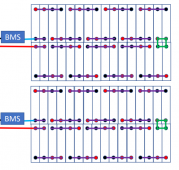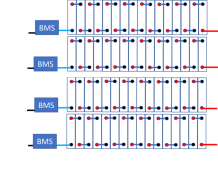It looks like you have already seen the resource document that covers various cell configurations so I won't go over all the info in there.
However, one aspect of Parallel first vs Serial first that I have not yet put in the pros & cons chart in the document is the balancing capability of the BMSs.
With Parallel first, the BMS is trying to balance large 'mega cells' with the same balance current. With Serial First there are more BMSs and therefore more balancing current. If you are starting with decent cells, balance them properly, and set up the balance settings in the BMS properly, this is not a big deal (Particularly with the powerful active balance capability of the JK BMS). However, it is one more aspect to consider when doing your planning.
For other folks: Here is the document I am talking about.
This short deck shows 1P and 2P cell configurations for 12V, 24V & 48V LiFePO4 batteries. To get the deck, click on the orange button at the top of this page. Note: Reviews, Comments and corrections are welcome Document Revision History...

diysolarforum.com
The busbar size is driven by the load you expect to put on the battery. You mentioned two 6548s. That is 13000W when at full capacity.
Assuming a 95% efficiency, the current for that will be:
(13000/.95)/48 = 285A.
In 'normal' operations, each battery will be providing ~ 143A. However, you indicated you would like to be able to run the system off of a single 2P16S battery so ideally, each battery would be able to handle the full 285A. However, your BMS will limit you to 200A so that will be the peak continuous current and the bus bars need to be able to handle at least 200A. (I would pick the busbar for 250A or more just to be on the safe side.)
This resource from
@kromc5 provides a nice table for busbar ampacity:
Ampacities of copper and aluminum busbars comparison table.

diysolarforum.com
You will probably be picking either 3/4" wide or 1" wide stock. I like to go thicker rather than wider because there is less conducting surface exposed. However, if you have welded studs on the cells, you must consider whether the thick Busbar, Lug, washer, lock washer, and nut will all fit on the stud. (I did not pay attention to this once and ended up having to counter-sink the nuts into the top of the busbar. The countersink had to be quite large in order to get a socket wrench around the nut. It was a real PITA that I would not do again.)
The table gives busbar ampacity at various temperatures. The chart does not say, but the ratings are probably for bare copper with no coverings. Consequently, I would lean toward using the 30deg-rise column because I like to heat-shrink the bar to help reduce the possibility of a short.
The other thing to consider is that copper and the aluminum on the cell pad will interact so at an absolute minimum you should use something like NO-LOX to seal up the connection. Using tinned busbars would be a far superior solution. I would recommend using tinned copper
and No-Lox.... but I will admit I am convinced that the infamous Murphy is out to get me. (Note: you can buy a tinned copper bar or you can tin the copper yourself)
I don't know where you live, but here in the States, I have had good luck buying copper bar stock from OnlineMetals.com. (I have no affiliation with them). Also, once you sign up to their system they will text a 15% discount code almost every month.
Online Metals carries copper bar in 110-H02. Each piece comes with a free MTR. Order pre-cut lengths or have it custom cut to the size you want.

www.onlinemetals.com







